People who regularly travel on an underground transport system like London's tube might consider a tour of such a system to be a pointless and slightly torturous way of spending a sunny Saturday afternoon. That's probably because they're never encountered a metro system like Moscow's, which, compared to the Underground, is utterly fantastic. Plans for the Moscow Metro date back to pre-WWI times but that war, the subsequent revolution, and the Russian Civil War that followed threw a wrench into those plans meaning construction didn't start until the 1930s. However when they did start, the first lines were built at a breakneck pace and in a style of such sumptuous beauty that the stations themselves are like art galleries through which trains happen to roll every few minutes.
Mayakovskaya Station, a UNESCO World Heritage site.
The construction of the Metro during the early Soviet era was seen as a way of proving the superiority of the Soviet system, especially in the 1930s, when the Great Depression in the west had capitalism floundering. The all-encompassing power of the government meant that they could mobilise huge numbers of workers toward the completion of the project very quickly.
"One of the main motivation factors of the mobilization was to overtake the West and prove that a socialist metro could surpass capitalist designs. It was especially important to the Soviet Union that socialism succeed industrially, technologically, and artistically in the 1930s, since capitalism was at a low ebb during the Great Depression." (Wikipedia. Of course.)
Apparently when Stalin announced plans for the construction of the Metro thousands of loyal communists turned put to help dig the tunnels by hand with pick axes, shovels and hand carts to remove debris. They included up to 10,000 member of the Soviet youth league (the Moscow Komsomol, now commemorated at Komsomolskaya Station). The resulting stations - above and below ground - really are fantastic. Almost all the walls and floors are covered in marble or granite, even in the long winding tunnels that connect different platforms underground. And the ceilings too are adorned with coffers or mosaics or chandeliers, or sometimes all three.
I elected to take a guided tour because I was hoping for a few worthwhile tidbits of trivia to include here. I had some luck with Moscow Free Tours who did the Red Square tour I took not long after arriving so I elected to take one of the not-free tours that complement their daily "free-but-tips-encouraged" offering (which is obviously a loss-leader for the rest of their schedule). I joined a 950 rouble (!) 90 minute tour starting from a station close the the Kremlin. I and a group of 7 other internationals were guided by the annoyingly perky and elfin Irina and the much calmer Pavel, through a large number of stations. Sadly, Irina used one of those portable headset microphones attached to a small speaker she wore around her neck which had the effect of distorting her bubbly commentary into the loud-and-unintelligible range while simultaneously irritating the normal Muscovite commuters around us. It was a bit cringey. I tried to stick with Pavel, who was quieter, more interesting, and spoke really excellent English.
Nonetheless, it was a worthwhile few hours. Irina was happy to repeat the oft-quoted-probably-completely-apocryphal story about the brown "circle line" that links the mostly radial system. The legend says that Metro planners were showing Stalin a map of the system and the leader put his coffee cup down on it, creating a brown ring centred on the page. Too afraid to question the man about his intentions, the engineers simply went ahead and built the circle line, reasoning it to be the safer choice.
Riding the Moscow Metro is generally a pleasure. Perhaps that's because I mostly do so outside rush hour when the trains aren't terribly crowded. Still there are undeniable advantages to the Moscow system over others I've used. First, it's really cheap. A single ride is 28 roubles, which is about 50p or 75 cents (compared to the minimum cost of a ride on the Tube which is currently about £2.10 for the shortest journeys). And that 28 roubles lets you ride anywhere in the system for as long as you want; there are no fare zones, no sliding scale of costs, and none of that peak/off peak malarky, just one price. It's brilliant. Also, the trains come very frequently. In busy times they arrive less than a minute apart, but even late at night you'd be hard-pressed to wait more than about two minutes. The average time between trains in 90 seconds. And each platform has a digital clock at the end showing the time elapsed since the last train departed, so you can get a pretty good idea of how long you can expect to wait.
My guided tour took us through many of the Metro's most fantastic stations. We visited the aforementioned Komsomolskaya Station, where the ceiling is adorned with mosaic of famous military struggles from Russian history, including two that have been retouched several times. The battles depicted range from the 13th century to the 20th, and two of the 20th century offerings have been retouched, some several times, to erase images of Stalin and replace them with those of Lenin.
The most famous station may well be Ploshchad Revolyutsii (Revolution Square), which is basically an underground sculpture gallery. Like most stations, there's a long hallway that separates the platforms and is punctuated by archways that lead onto the two opposing platforms. Each of the archways is adorned with a pair of bronze statues depicting sturdy proletarians of all types - soldiers, mothers, students and sportsmen.
Novoslobodskaya is also well-known because its hall is lined with backlit stained glass panels. (Seriously? Stained glass in a metro station?!?) It's said that the Moscow Metro stations were intended to be "palaces for the people" and stations like Novoslobodskaya make that claim hard to dispute. I'm sure the cost was staggering, and I suppose it would be impossible to repeat in a different era, but it does make one contemplate how many opportunities there are to create beauty in public spaces, and how infrequently those opportunities are taken.
Of course beyond the stunning beauty of the architecture, there's a functioning train system. And like other underground systems, there are fables that go along with it. For instance, there are rumours of what's known as Metro 2, a set of deep lines linking important government and military sights, to be used for evacuation of key personnel in the event of a nuclear attack. It's sort of like the Soviet analogue to the much more sedate London Post Office Railway. And there are these:
Dotted around the system, these are apparently big blast doors that conceal tunnels meant to be used as bomb shelters.
And these appear in every station - they're bomb boxes. Used to contain suspicious packages that might be terrorist bombs. Eek.
Like in London, underground stations were used as bomb shelters during WWII; the legend is that more than 150 babies were born in the Moscow Metro during that time. Also like in London, there are announcements made as each train enters and leaves the station. Sadly, the typically muffled/distorted nature of these announcements coupled with my extremely shaky Russian language skills mean that I struggle just to catch the name of the station, let alone the accompanying pleasantries. But Pavel let me in on my favourite bit of Moscow Metro trivia, relating to these announcements. Inside the circle line, voiceovers are in a male voice but outside the brown line the voice is female. And if you're traveling on the circle line you get one voice going clockwise and the other going counterclockwise! Fantastic.
And so ends our brief trip into the Moscow Metro. As usual, there are more photos at Flickr. As for me, work is busy and frustrating, but nothing that I didn't expect. There are rumours I may get to move to a more central flat after all, but I've resolved not to stress about this one way or the other. And I've had some success with my Russian, though progress is slow. I should probably be studying a bit more (or at all...) but frankly I find that's the last thing I feel like doing in the small amount of spare time left to me. In the mean time, stay tuned, and I'll try to keep up with the blogging as long as the schedule allows. Until then, до свидания.
And so ends our brief trip into the Moscow Metro. As usual, there are more photos at Flickr. As for me, work is busy and frustrating, but nothing that I didn't expect. There are rumours I may get to move to a more central flat after all, but I've resolved not to stress about this one way or the other. And I've had some success with my Russian, though progress is slow. I should probably be studying a bit more (or at all...) but frankly I find that's the last thing I feel like doing in the small amount of spare time left to me. In the mean time, stay tuned, and I'll try to keep up with the blogging as long as the schedule allows. Until then, до свидания.



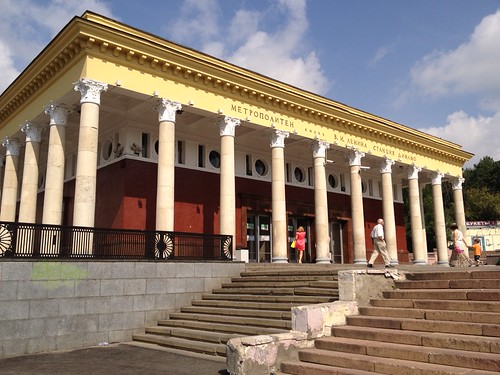

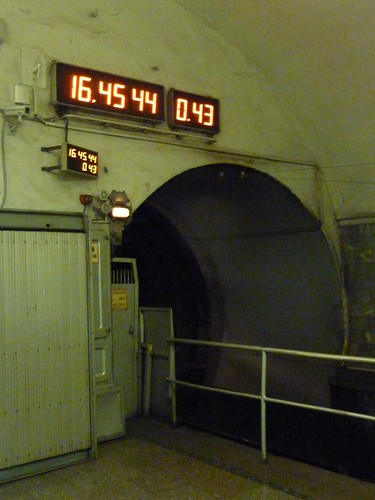
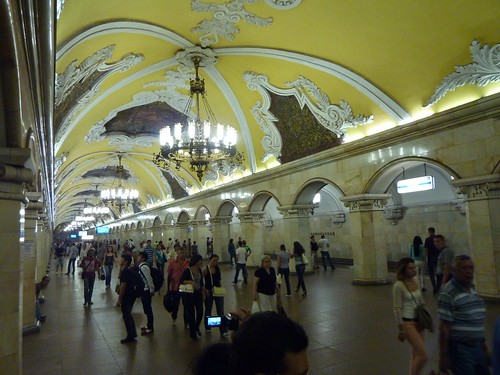
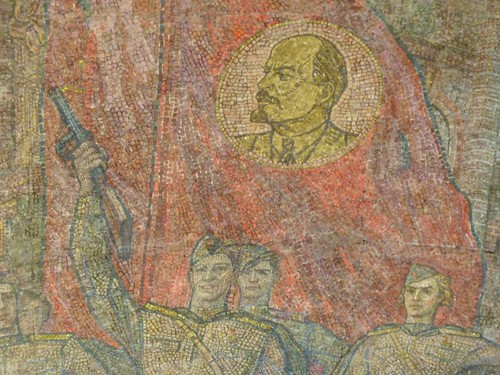

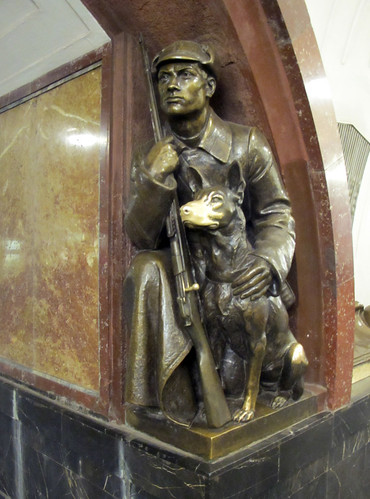

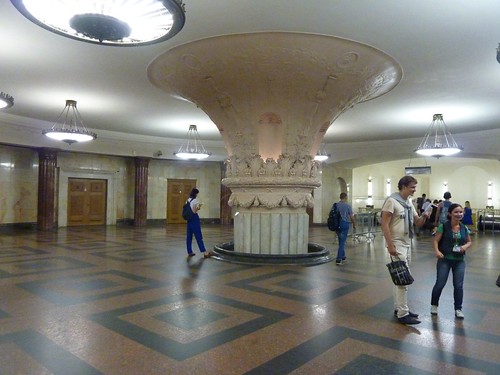


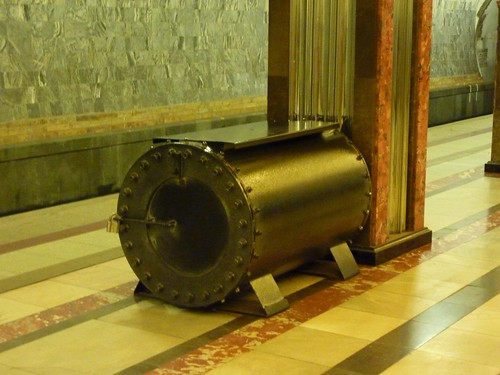


1 Comment:
Beautiful Metro Stations!
They do look like they would cost a bundle.
Difficult to ask your government to spend more when you think taxes are already too high.
Keep up the good blogs, however the photos of Pam have been few and far between...
rh
Post a Comment